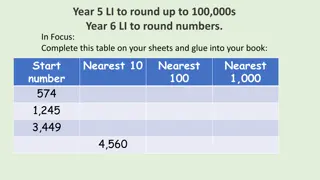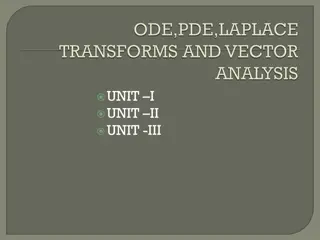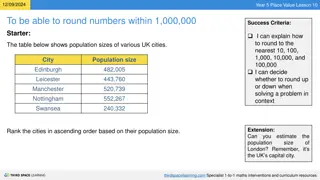
Renal Physiology Lectures and Equations for Understanding Kidney Function
Explore comprehensive lectures on renal functions, GFR, clearance, and kidney physiology with detailed equations. Learn about renal blood flow, filtration processes, and regulation mechanisms in the kidneys.
Download Presentation

Please find below an Image/Link to download the presentation.
The content on the website is provided AS IS for your information and personal use only. It may not be sold, licensed, or shared on other websites without obtaining consent from the author. If you encounter any issues during the download, it is possible that the publisher has removed the file from their server.
You are allowed to download the files provided on this website for personal or commercial use, subject to the condition that they are used lawfully. All files are the property of their respective owners.
The content on the website is provided AS IS for your information and personal use only. It may not be sold, licensed, or shared on other websites without obtaining consent from the author.
E N D
Presentation Transcript
Physiology Team 436 Renal Block Values and Equations File Color Index: Equation Number Unit Notes Only female slides Only males slide Both female and males slides Done by: Rana Barasain - Laila Mathkour 1 This work was done by students, so if there are any mistakes please inform us.
Lectures: Renal Functions, GFR, Clearance, Micturition, Acid base balance, Buffer systems. THIS IS THE MAIN EQUATION: Clearance = U . V / P GFR:we use creatinine 125 ml/min or 180 L/day ml/min RPF:we use PAH because it is completely secreted. Renal blood flow = RPF / 1 hematocrit (the high RBF is a feature of renal circulation) (around 1200) = 625 / (1 0.45) (20% of cardiac output is renal blood flow, and 20% of renal plasma flow will be filtered) Filtration Fraction = GFR / Renal plasma flow (no unit) 0.2 = 125 / 625 Amount of substance excreted = filtration rate +- tubular handling (filtered reabsorbed + secreted) U . V (EXCRETION RATE) = C . P (FILTERED) Reabsorption = Filtered load (C . P) Excretion rate (U . V) mmol/min Secretion rate = Excretion rate Filtration load K (140 age) Body weight (kg) GFR = (this is the Cockcroft-Gault equation for clearance) Serum creatinine ( mol/L) K = 1.23 for males 1.04 for females GFR = Kf x net filtration pressure 125 = 12.5 x 10 GFR = Kf x [(PG-PB)-( G- B) P = Hydrostatic = Colloid Net filtration pressure = Glomerular hydrostatic Glomerular colloid Bowman s hydrostatic (mmHg) 10 = 60 32 18 CONVERSION IN BIOCHEMISTRY: 1 mg/dl = 88.4 micro mol / l Laplace Law: P = 2T / r Acid [AH] Dissociation constant: K = [H+] x [A-] conjugate base [A-] + [H+] [AH] pH = - Log [H+] pH = pK + Log ___HCO3-___ pK = dissociation constant = 6.1 (Dr.Maha said we don t need to know the steps that lead up to it) 0.03 x PCO2 2
Lecture #1 Renal functions & GFR KIDNEYS weight Each kidney has Blood flows through juxta medullary nephrons Renal blood flow to the kidney represents Blood flow rate of renal circulation GFR 150 grams 1 million nephrons 1-2 % 20% of cardiac output 1200 ml/min 125 ml/min = 20% renal plasma flow. 60 mmHg Glomerular hydrostatic pressure Hydrostatic pressure in bowman s capsule Colloid osmotic pressure of glomerular plasma proteins Net filtration pressure 18 mmHg 32 mmHg 60-18-32= 10 mmHg 200 liters of blood daily Kidney filter
Lecture #2 Regulation of GFR The volume of filtrate produced by both kidneys per min Averages 125 ml/min Totals about 180L/day (45 gallons) GFR remains constant over a large range of values of BP systemic cardiac output flows through the kidneys each minute plasma entering the glomerulus is filtered filtered fluid 75-160 mmHg 1200 ml 20% 125 ml/min Sodium reabsorption of filtered sodium is absorbed 99.5% Proximal tubules (67%) Loop of Henle (25%) Distal/Collectin g tubules (8%) 60mmHg Forces in capillaries: hydrostatic pressure PGC oncotic pressure GC - 29 mmHg 4
Lecture #2 Regulation of GFR Net outward pressure Forces in capsule: hydrostatic pressure PBS oncotic pressure GBS Overall 60 29 = 31mmHg -15mmHg 0 mmHg 31 15 = 16 mmHg outward Male adults GFR Female GFR ~ 90 140 ml/min 80 125 ml/min Lecture #3 Renal clearance Tm for Glucose [Inulin]urine [Inulin]plasma urine flow rate 60 29 = 31mmHg = 30 mg/ml = 0.5 mg/ml = 2 ml/min 5
Lecture #4 Physiology of micturition A nervous reflex called the micturition reflex occurs that empties the bladder at [Inulin]urine [Inulin]plasma urine flow rate 150-200mls of urine volume = 30 mg/ml = 0.5 mg/ml = 2 ml/min urge to void urine 150-300 ml sense of fullness of U.B 300-400 ml sense of discomfort 400-600 ml sense of pain 600-700 ml micturition can t be suppressed 700 ml 6
Lecture #5+6 Renal Transport Process Reabsorped daily by renal tubules 25,000 mEq/day Na+ 179 L/day water 2.5-6.5 mM/L (15- 39 mg/100ml) 3,500-4,000 mmol 98 % is intracellular, [150mM] 2% K extra-cellular [3.5-5mM] Normal plasma level of urea Potassium in blood K+ Intake 80-120 mmol/day K content of average meal Dietary K excreted via the kidneys K in Sweat & Feces (This is unregulated and may become significant in diarrheas) Filtered load of potassium 30-40mmol 90-95% 5-10% 720 mmol/day 7
Lecture #8 Urine Concentration Mechanism 150 mOsm/kg water diluting tubule fluid Water reabsorption % 65%in Proximal convoluted tubule 20-25%in Thin Descending limb ZERO in thick and thin Ascending limb 1200 mOsm/kg Osmolality of medullary tissue high up to Bu medullary blood flow less than 5% Lecture #9 Basics acid base pH of water Normal pH 7 -log [0.00000004] M=7.4 145 mM/L ECF [Na+] Normal BLOOD pH 7.35 7.45 pH range Compatible with human life (6.8-7.8) 8
Lecture #10 Buffer system total chemical buffering of body fluids HCO3 - FREELY FILTERABLE at glomeruli Maximum urine acidity 60 - 70% (3 mM/min) pH 4.5 to urine [H+] of only ~ 0.03 mM/L. equates Lecture #11acid base disorder Respiratory Acidosis ACUTELY 1 mEq/L [HCO3-] per 10 mm Hg in Pco2 CHRONICALLY 3.5 mEq/L [HCO3-] per 10 mm Hg in Pco2 How to Analyze an ABG PO2 pH PCO2 HCO3 80-100mmHg 7.35_7.45 35-45 mmHg 22-26 mmol/L normal acidotic - <7.35 >45 < 22 alkalotic - >7.45 <35 > 26 9
YOU ARE DONE! . : . Good luck our DOCTORS! See you next year! Physiology Team436 10






















